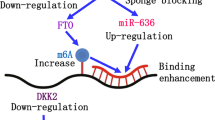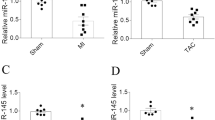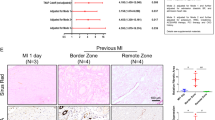Abstract
Cardiac fibrosis is involved in myocardial remodeling following acute myocardial infarction (AMI), which can result in heart failure, arrhythmias and even sudden cardiac death. Investigating the molecular mechanisms of cardiac fibrosis in acute myocardial infarction (AMI) is essential for better understanding this pathology. The current study aims to investigate the effect of TUG1 on cardiac fibrosis after AMI and elucidated the underlying molecular mechanism of AMI. Rats were randomly divided into four groups (sham-operation group, myocardial infarction group (AMI group), si-NC treated group and si-TUG1 treated group). The biological behavior of cardiac fibroblasts treated with TGF-β1after being transfected by si-TUG1 or miR-590 mimic or miR-590 inhibitor or FGF1 mimic or a combination was evaluated using the cell counting kit-8 (CCK8) and Transwell assays. SatarBase v2.0 was used to predict the target microRNAs binding site candidates with TUG1 and FGF1. Western blot and recovery experiments were used to explore the potential mechanism. TUG1 expression was up-regulated and knockdown of TUG1 improved cardiac function in AMI rats. Knockdown of TUG1 suppressed cell viability and migration and improved collagen production of TGF-β1 treated cardiac fibroblasts. SatarBase v2.0 showed TUG1 served as a sponge for miR-590 and FGF1 is a direct target of miR-590. TUG1 expression was increased in AMI tissue and cardiac fibroblasts treated with TGF-β1. TUG1 knockdown suppressed the biological process of cardiac fibroblasts treated with TGF-β1 by sponging miR-590.





Similar content being viewed by others
References
Ai Y, Chen M, Liu J, Ren L, Yan X, Feng Y (2020) lncRNA TUG1 promotes endometrial fibrosis and inflammation by sponging miR-590-5p to regulate Fasl in intrauterine adhesions. Int Immunopharmacol 86:106703
Bartel DP (2009) MicroRNAs: target recognition and regulatory functions. Cell 136:215–233
Benjamin EJ, Blaha MJ, Chiuve SE, Cushman M, Das SR, Deo R, de Ferranti SD, Floyd J, Fornage M, Gillespie C, Isasi CR, Jimenez MC, Jordan LC, Judd SE, Lackland D, Lichtman JH, Lisabeth L, Liu S, Longenecker CT, Mackey RH, Matsushita K, Mozaffarian D, Mussolino ME, Nasir K, Neumar RW, Palaniappan L, Pandey DK, Thiagarajan RR, Reeves MJ, Ritchey M, Rodriguez CJ, Roth GA, Rosamond WD, Sasson C, Towfighi A, Tsao CW, Turner MB, Virani SS, Voeks JH, Willey JZ, Wilkins JT, Wu JH, Alger HM, Wong SS, Muntner P (2017) Heart disease and stroke statistics-2017 update: a report from the American Heart Association. Circulation 135:e146–e603
Bujak M, Frangogiannis NG (2007) The role of TGF-beta signaling in myocardial infarction and cardiac remodeling. Cardiovasc Res 74:184–195
Geisler S, Coller J (2013) RNA in unexpected places: long non-coding RNA functions in diverse cellular contexts. Nat Rev Mol Cell Biol 14:699–712
Han X, Hong Y, Zhang K (2018) TUG1 is involved in liver fibrosis and activation of HSCs by regulating miR-29b. Biochem Biophys Res Commun 503:1394–1400
He S, Shi D, Han Z, Dong Z, Xie Y, Zhang F, Zeng W, Yi Q (2019) Heparinized silk fibroin hydrogels loading FGF1 promote the wound healing in rats with full-thickness skin excision. Biomed Eng Online 18:97
Huang S, Zhang L, Song J, Wang Z, Huang X, Guo Z, Chen F, Zhao X (2019) Long noncoding RNA MALAT1 mediates cardiac fibrosis in experimental postinfarct myocardium mice model. J Cell Physiol 234:2997–3006
Liu X, Xu Y, Deng Y, Li H (2018) MicroRNA-223 regulates cardiac fibrosis after myocardial infarction by targeting RASA1. Cell Physiol Biochem 46:1439–1454
Livak KJ, Schmittgen TD (2001) Analysis of relative gene expression data using real-time quantitative PCR and the 2(-Delta Delta C(T)) method. Methods 25:402–408
MacKenzie B, Korfei M, Henneke I, Sibinska Z, Tian X, Hezel S, Dilai S, Wasnick R, Schneider B, Wilhelm J, El Agha E, Klepetko W, Seeger W, Schermuly R, Gunther A, Bellusci S (2015) Increased FGF1-FGFRc expression in idiopathic pulmonary fibrosis. Respir Res 16:83
Mattick JS, Rinn JL (2015) Discovery and annotation of long noncoding RNAs. Nat Struct Mol Biol 22:5–7
Mercer TR, Dinger ME, Mattick JS (2009) Long non-coding RNAs: insights into functions. Nat Rev Genet 10:155–159
Pan Z, Sun X, Shan H, Wang N, Wang J, Ren J, Feng S, Xie L, Lu C, Yuan Y, Zhang Y, Wang Y, Lu Y, Yang B (2012) MicroRNA-101 inhibited postinfarct cardiac fibrosis and improved left ventricular compliance via the FBJ osteosarcoma oncogene/transforming growth factor-beta1 pathway. Circulation 126:840–850
Rapicavoli NA, Blackshaw S (2009) New meaning in the message: noncoding RNAs and their role in retinal development. Dev Dyn 238:2103–2114
Shinde AV, Frangogiannis NG (2014) Fibroblasts in myocardial infarction: a role in inflammation and repair. J Mol Cell Cardiol 70:74–82
Small EM, Frost RJ, Olson EN (2010) MicroRNAs add a new dimension to cardiovascular disease. Circulation 121:1022–1032
Su Q, Liu Y, Lv XW, Dai RX, Yang XH, Kong BH (2020) LncRNA TUG1 mediates ischemic myocardial injury by targeting miR-132-3p/HDAC3 axis. Am J Physiol Heart Circ Physiol 318:H332–H344
Sun F, Zhuang Y, Zhu H, Wu H, Li D, Zhan L, Yang W, Yuan Y, Xie Y, Yang S, Luo S, Jiang W, Zhang J, Pan Z, Lu Y (2019) LncRNA PCFL promotes cardiac fibrosis via miR-378/GRB2 pathway following myocardial infarction. J Mol Cell Cardiol 133:188–198
Tay Y, Rinn J, Pandolfi PP (2014) The multilayered complexity of ceRNA crosstalk and competition. Nature 505:344–352
Travers JG, Kamal FA, Robbins J, Yutzey KE, Blaxall BC (2016) Cardiac fibrosis: the fibroblast awakens. Circ Res 118:1021–1040
Wang X, Yong C, Yu K, Yu R, Zhang R, Yu L, Li S, Cai S (2018) Long noncoding RNA (lncRNA) n379519 promotes cardiac fibrosis in post-infarct myocardium by targeting miR-30. Med Sci Monit 24:3958–3965
Wang Y, Jin BJ, Chen Q, Yan BJ, Liu ZL (2019) MicroRNA-29b upregulation improves myocardial fibrosis and cardiac function in myocardial infarction rats through targeting SH2B3. Eur Rev Med Pharmacol Sci 23:10115–10122
White HD, Chew DP (2008) Acute myocardial infarction. Lancet 372:570–584
Yang D, Yu J, Liu HB, Yan XQ, Hu J, Yu Y, Guo J, Yuan Y, Du ZM (2019) The long non-coding RNA TUG1-miR-9a-5p axis contributes to ischemic injuries by promoting cardiomyocyte apoptosis via targeting KLF5. Cell Death Dis 10:908
Young TL, Matsuda T, Cepko CL (2005) The noncoding RNA taurine upregulated gene 1 is required for differentiation of the murine retina. Curr Biol 15:501–512
Yuan X, Pan J, Wen L, Gong B, Li J, Gao H, Tan W, Liang S, Zhang H, Wang X (2020) MiR-590-3p regulates proliferation, migration and collagen synthesis of cardiac fibroblast by targeting ZEB1. J Cell Mol Med 24:227–237
Zang XJ, Li L, Du X, Yang B, Mei CL (2019) LncRNA TUG1 inhibits the proliferation and fibrosis of mesangial cells in diabetic nephropathy via inhibiting the PI3K/AKT pathway. Eur Rev Med Pharmacol Sci 23:7519–7525
Zhong X, Chung AC, Chen HY, Meng XM, Lan HY (2011) Smad3-mediated upregulation of miR-21 promotes renal fibrosis. J Am Soc Nephrol 22:1668–1681
Zhou C, Cui Q, Su G, Guo X, Liu X, Zhang J (2016) MicroRNA-208b alleviates post-infarction myocardial fibrosis in a Rat model by inhibiting GATA4. Med Sci Monit 22:1808–1816
Zou X, Wang J, Tang L, Wen Q (2019) LncRNA TUG1 contributes to cardiac hypertrophy via regulating miR-29b-3p. In Vitro Cell Dev Biol Anim 55:482–490
Acknowledgements
This work was supported by The Affiliated Huaian No.1 People's Hospital of Nanjing Medical University.
Author information
Authors and Affiliations
Corresponding authors
Ethics declarations
Conflict of interest
All authors declare no conflicts of interest.
Additional information
Publisher's Note
Springer Nature remains neutral with regard to jurisdictional claims in published maps and institutional affiliations.
Rights and permissions
About this article
Cite this article
Sun, Q., Luo, M., Gao, Z. et al. TUG1 knockdown suppresses cardiac fibrosis after myocardial infarction. Mamm Genome 32, 435–442 (2021). https://doi.org/10.1007/s00335-021-09895-z
Received:
Accepted:
Published:
Issue Date:
DOI: https://doi.org/10.1007/s00335-021-09895-z




